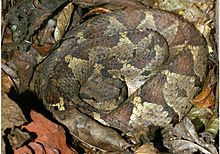- Atropoides nummifer
-
Atropoides nummifer 
Central American jumping pitviper,
A. n. mexicanusConservation status Scientific classification Kingdom: Animalia Phylum: Chordata Subphylum: Vertebrata Class: Reptilia Order: Squamata Suborder: Serpentes Family: Viperidae Subfamily: Crotalinae Genus: Atropoides Species: A. nummifer Binomial name Atropoides nummifer
(Rüppell, 1845)Synonyms - Atropos nummifer - Rüppell, 1845
- T[rigonocephalus]. nummifer - Jan, 1859
- T[eleuraspis]. nummifer - Cope, 1860
- B[othrops]. nummifer - Jan, 1863
- Th[anotos]. nummifer - Posada Arango, 1889
- Th[anotophis]. nummifer - Posada Arango, 1889
- Bothriechis nummifera - Günther, 1895
- Lachesis nummifer - Boulnger, 1896
- Lachesis nummifera - Boettger, 1898
- Trimeresurus nummifer - Mocquard, 1909
- Bothriochis mammifera - Recinos - 1913
- Bothrops nummifera - March, 1929
- T[rimeresurus]. n[ummifer]. nummifer - Dunn, 1939
- Bothrops nummifer nummifer - Burger, 1950
- Bothrops nummifer veraecrusis - Burger, 1950
- Porthidium nummifer - Campbell & Lamar, 1989
- Atropoides nummifer - Werman, 1992[1]
Atropoides nummifer is a venomous pitviper species found in Mexico and Central America. Currently, 3 subspecies are recognized, including the nominate subspecies described here.[4]
Contents
Description
Adults are short and exceedingly stout, commonly growing to 18-24 inches (46-61 cm) in length. The snout is rounded with a sharp canthus.[3]
At midbody there are 23-27 rows of dorsal scales that are strongly keeled, tubercular in large specimens. The ventral scales are 121-135, while the subcaudals are 26-36 and mostly single. The eye is separated from the labial scales by 3-4 rows of small scales.[3]
The color pattern consists of a tan, light brown or gray ground color that is overlaid with a series of around 20 dark brown or black rhomboid blotches. The lower tips of these blotches often connect with spots on the flanks to form narrow crossbands. The top of the head is dark with oblique postorbital stripes, below which the side of the head is a lighter color. The belly is whitish, occasionally with dark brown blotches.[3]
These snakes have sometimes been mistaken for young bushmasters (Lachesis muta), but can easily be identified by their lack of a specialized tail tip.[3]
Geographic range
Found in eastern Mexico from San Luis Potosí southeastward on the Atlantic versant and lowlands through northern Guatemala, southern Belize, Honduras, Nicaragua and Costa Rica to central Panama. On the Pacific versant in disjunct populations from southern Mexico, Guatemala, El Salvador, Costa Rica and Panama. Found in various types of forest, including cloud forest and rain forest at 40-1600 m altitude. The type originally lacked locality information, but apparently "Mexico" was filled in some time later. A restriction to Teapa, Tabasco, Mexico, was proposed by Burger (1950).[1]
Conservation status
This species is classified as Least Concern (LC) on the IUCN Red List of Threatened Species (v3.1, 2001).[5] Species are listed as such due to their wide distribution, presumed large population, or because it is unlikely to be declining fast enough to qualify for listing in a more threatened category. The population trend is stable. Year assessed: 2007.[6]
Subspecies
Subspecies[4] Taxon author[4] Common name[2] Geographic range A. n. mexicanus (Duméril, Bibron & Duméril, 1854) Central American jumping pitviper Type locality: Cobán, Alta Verapaz, Guatemala. A. n. nummifer (Rüppell, 1845) Mexican jumping pitviper Type locality: Mexico. A. n. occiduus (Hoge, 1966) Guatemalan jumping pitviper Type locality: San Augustín, Guatemala. See also
- List of crotaline species and subspecies
- Crotalinae by common name
- Crotalinae by taxonomic synonyms
- Snakebite
References
- ^ a b McDiarmid RW, Campbell JA, Touré T. 1999. Snake Species of the World: A Taxonomic and Geographic Reference, vol. 1. Herpetologists' League. 511 pp. ISBN 1-893777-00-6 (series). ISBN 1-893777-01-4 (volume).
- ^ a b Campbell JA, Lamar WW. 2004. The Venomous Reptiles of the Western Hemisphere. 2 volumes. Comstock Publishing Associates, Ithaca and London. 870 pp. 1500 plates. ISBN 0-8014-4141-2.
- ^ a b c d e U.S. Navy. 1991. Poisonous Snakes of the World. US Govt. New York: Dover Publications Inc. 203 pp. ISBN 0-486-26629-X.
- ^ a b c "Atropoides nummifer". Integrated Taxonomic Information System. http://www.itis.gov/servlet/SingleRpt/SingleRpt?search_topic=TSN&search_value=585757. Retrieved 14 September 2007.
- ^ Atropoides nummifer at the IUCN Red List. Accessed 14 September 2007.
- ^ 2001 Categories & Criteria (version 3.1) at the IUCN Red List. Accessed 14 September 2007.
External links
- Atropoides nummifer at the Reptarium.cz Reptile Database. Accessed 14 September 2007.
Categories:- IUCN Red List least concern species
- Crotalinae
- Reptiles of Central America
- Reptiles of Guatemala
- Reptiles of Belize
- Reptiles of Honduras
Wikimedia Foundation. 2010.

